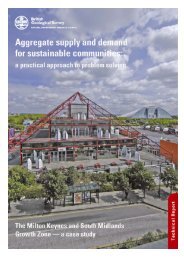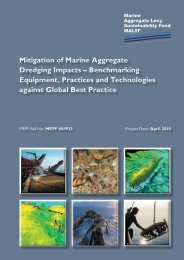creating environmental improvements through biodiversity
creating environmental improvements through biodiversity
creating environmental improvements through biodiversity
You also want an ePaper? Increase the reach of your titles
YUMPU automatically turns print PDFs into web optimized ePapers that Google loves.
information and starting to undertake seminars<br />
Long term aftercare -<br />
• Barrier highlighted by minerals industry:<br />
• Response from Countryside Agency on aftercare of sites is inconsistent across regions, some regions<br />
saying they do not have resources to get involved<br />
Table discussing effectiveness of mechanisms <strong>through</strong> which statutory bodies and minerals industry interact.<br />
Summary of the main themes highlighted in the tables. Main focus on problems at the planning stage and<br />
difficulties implementing monitoring – fewer problems during restoration due to better statutory body<br />
communication. Highlighted the need for specific guidance from statutory bodies and good practice<br />
examples (ALSF-funded restoration case studies?); flexibility by statutory bodies rather than a prescriptive<br />
approach; better co-ordination between the industry and statutory bodies; and consistency across and within<br />
organisations.<br />
Impacts (Actual):<br />
The workshop brought together representatives from government and industry in a useful discussion.<br />
Concerns of the industry were highlighted, and provisions made by statutory bodies (guidance etc.) were<br />
brought to attention. Impacts may have been greater if the other invited statutory bodies had attended.<br />
Impacts (Potential):<br />
The workshop could help to increase understanding between the industry and statutory bodies.<br />
Potential Expansion:<br />
Similar workshops could be arranged in different regions and on specific topics to facilitate communication<br />
between the different sectors.<br />
Dissemination:<br />
Results of the workshop were summarised in the document, providing interesting pointers for all<br />
stakeholders. It was presumably distributed to all delegates, but was an ‘unpublished project report’. It may be<br />
useful to incorporate some of the main points into more widely distributed material.<br />
The workshop included an assessment of different forms of information dissemination between the industry<br />
and statutory bodies, highlighting the advantages of: case studies, leafleting, web based information and<br />
training; and both advantages and disadvantages of forums, current guidance information, and current position<br />
statements.<br />
Sustainable Aggregates Creating Environmental Improvements <strong>through</strong> Biodiversity<br />
IDLE VALLEY PROJECT VISION DOCUMENT – VISION STATEMENT<br />
(NOTTINGHAMSHIRE WILDLIFE TRUST – FOLLOW-UP DOCUMENT<br />
FROM MIRO MIST ADAS REPORT ‘IDLE VALLEY WIDE-AREA PROJECT<br />
FEASIBILITY STUDY’ 2004)<br />
September 2004<br />
Project Type: Summary, project update<br />
Site: The central Idle Valley, Nottinghamshire<br />
Project Aim: To secure the exceptional range of habitats in the area in perpetuity, <strong>through</strong> a partnership<br />
project involving public and private sector interests linked <strong>through</strong> the Trust’s charitable activities. To<br />
demonstrate that conservation and enhancement of <strong>biodiversity</strong> can be central to economic and social<br />
regeneration. To demonstrate the advantages of this type of sustainable development and serve as a model<br />
73

















